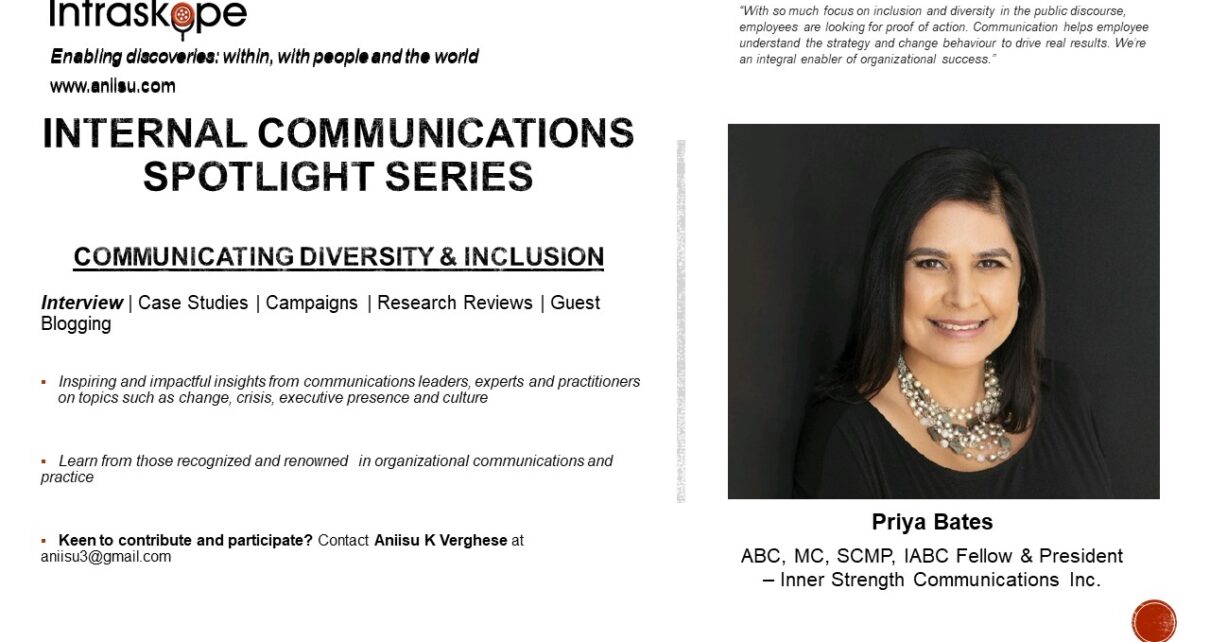Welcome to the 17th edition of Intraskope’s Spotlight Series featuring Priya Bates, an internal communication, employee engagement and change management strategist who works with Fortune 500 companies to enable, engage and empower employees to manage change and deliver results.
How important is communicating diversity and inclusion at the workplace? What must communicators and leaders do more to create a culture of inclusion at work? Watch this interview with Priya Bates, ABC, MC, SCMP and IABC Fellow to learn more. Priya runs Inner Strength Communications and is based in Canada. As a strong advocate of diversity and inclusion at the workplace she outlines why and how communicators can get stronger in this emerging domain.
About Intraskope’s Spotlight Series
In this series I interview key thought leaders on topics interrelated with internal communications such as culture, crisis, change, executive presence and leadership. The goal is to help unravel why they matter, what can leaders and communicators learn from experts and how we can put insights to practice. Watch these short interviews and get better at understanding these key topics and how you engage with internal communications.
I spoke to Priya on the importance of diversity and inclusion communications, why it matters more than ever today and what organizations and communicators can do better to make this topic a part of the everyday.
Priya has worked with numerous clients to teach people teams how to focus on communication to drive the employee and customer experience. At Inner Strength Communication, she uses her expertise to enable, engage and empower employees to manage change and deliver results. Beyond work, she is engaged in empowering voices of women of colour to drive career progress and amplifying diverse set of voices through conferences.
“The role of communication is to communicate changes and expectations, drive clear links to behaviour and then highlight what good looks like through recognition and storytelling. When employees see and hear from leaders like them that they can relate too, they feel like they can bring their true selves to work to drive a sense of belonging”, says Priya.
Interview
1. How important is communicating inclusion and diversity at the workplace?
Some people would like to think about the global focus on Diversity, Inclusion, Equity and Belonging a ‘trend’ or a moment that will pass. The truth is that it is a global movement forcing us to have tough conversations about who we are as organizations and individuals. It’s asking us to look at our values and bring them to life. With so much focus on inclusion and diversity in the public discourse, employees are looking for proof of action. Communication helps employee understand the strategy and change behavior to drive real results. We’re an integral enabler of organizational success.
2. What do you think is the role of internal communications in helping create an environment where everyone can bring their best selves to work?
Without internal communication, the values and culture we strive for in organizations are simply words on paper or displayed on a wall. It’s an aspiration versus a reality. The role of communication is to communicate changes and expectations, drive clear links to behaviour and then highlight what good looks like through recognition and storytelling. When employees see and hear from leaders like them that they can relate too, they feel like they can bring their true selves to work to drive a sense of belonging. Ultimately, employees want to feel valued.
3. Based on your experience, can you share a couple of examples of great practices in communications related to this area?
I’ve had the pleasure of working with a few organizations on their DEI communication plans this past year. Those that are making real progress and reaping the benefits of that change are looking closely at operations and everyday behaviors. Beyond unconscious bias and anti-black racism training, they are driving systemic changes through the employee lifecycle. This includes a good look at practices and processes from recruitment, orientation, performance and talent management, recognition, and exit. They are holding themselves accountable to real measurable progress over time with deadlines to meet commitments. They are also recognizing the imperative of doing the real work to live up to their own values and culture commitments.
4. What are some pointers while communicators address this important area of inclusion and diversity inside organizations?
Make sure there is a business plan that you can support. If one doesn’t exist and organizations are simply checking boxes but not driving real change, the opportunity for success is slim. Simply stating commitments for DEI but not following up with visible action will be superficial by diverse employees and allies and may result in disengagement and lack of retention.
I talk about the 4 A’s –
- Acknowledge the issue. Leaders need to believe that there is an issue with diversity, inclusion, equity and belonging that needs to be addressed before they can drive real change.
- Be Aware of what this means from a data standpoint in your own organization. Does your leadership reflect the diversity (race, gender, sexual-preference, ability) of colleagues, community and customers? If not, why not?
- Create an Action Plan for changes. What will we do to drive change.
- Be Accountable to results to measure progress.
5. How can communicators get better with advising leaders about inclusion and diversity practices?
Years of research has told us that more diversity leads to more innovation and better business results. Understand what this means for your organization. Any connections to the organization’s values, reputation, strategy, employee experience, and customer experience make imperatives more powerful.
With grocery retailers, we talk about the changing demographics of those buying our products and the growth of privately-owned supermarkets meeting a need we cannot.
With a school board that is seeing a drop in enrollment, we talk about the changes happening in communities and what diverse groups value that are driving parents to register their children in one school board versus another.
With private schools, we talk about the fact that the Alpha generation will be one where non-white minorities will be the majority of students. If they don’t feel they belong in your institution, it will impact bottom line.
With a legal organization, we talk about legislation being drafted by white leaders that impact the lives of the indigenous and black communities disproportionately. What perspectives need to be at the table to consider these impacts and drive change?
IABC has said that business acumen is an important skill for communication leaders to have. I agree that you need to understand the business and know what is important to leaders to make progress.
6. What are a couple of trends you spot in this space of diversity and inclusion communications?
We’re amazed with how many internal communication professionals have been handed the DEI mandate in their organizations with limited experience and training. They are doing their best with what they know navigating a space with limited resources and a real business mandate. I want to be able to connect these practitioners to share best practices and have access to credible global resources to help them support real progress and change.
The other trend is that this is a movement – not a moment. Some were hoping the conversation would go away but it is gaining momentum as we apply a fairness lens across the board.
I’ve started to hear a change in terminology. We’re moving from talking about Diversity Equity and Inclusion to Belonging, Dignity and Justice in the workplace. These are very different words that are really powerful. I think the voices have been empowered and change is happening. Some organizations will lead (those are the ones I’m working with that are ready to do the hard work and take a good look at themselves with eyes wide open). Others are going to follow because their competitors are reaping the benefits and they do not want to be left behind. Finally, there will be those who are forced to change because a new expectation has been created that is impacting their bottom line – retention, recruitment, reputation, results – negatively. The question for this final group is whether it will be too late.
Watch the complete video interview on YouTube or read the complete transcript above.
Missed the earlier episodes? Watch them here: D. Mark Schumann (Culture), Peter Yorke (Executive Presence), Sia Papageorgiou (Leadership Communications), Dianne Chase (Strategic Storytelling), Gloria Walker (Communication Planning), Rebecca Sangster-Kelly (Stakeholder Management), Ray Walsh (Localizing Employee Communications), Prof. Matt Tidwell (Reputation), Geri Rhoades (Manager Communications), Erik K Meyers (Business Acumen), Russell-Olivia Brooklands (IC Practice Governance), Paul Barton (Public Speaking and Business Communication), Cyrus Mavalwala (Digital Communication), Elvera N Makki (Social Impact Communication), Philippe Borremans (Communication Preparedness) and Magdalena Petryniak (Influence in Communications).
You can also look up the ongoing Intraskope’s Spotlight on Internal Communication Series featuring practitioners from around the globe sharing best practices and perspectives.
Liked the interview? Post your comments and share it with your network.
Keen to participate in the ongoing series on Personal Branding, Crisis Communications, Internal Communications or CSR Communications? Drop me a note at [email protected]
Here are Internal Communications resources you can use:
- Learn: Internal Communications Fundamentals Course on Thinkific
- Internal Communications Series: https://forms.gle/KcqmPzLwq7NQi5Km6
- Chat with Aniisu – Internal Communications: https://www.instamojo.com/intraskope/connect-with-aniisu-60-minute-personalized-d/?ref=store
- Internal Communications workshops: https://bit.ly/2zdBRl1
You can also visit my website www.intraskope.com and You Tube channel to know more about my work.
#IC #diversity #inclusion #D&I #belonging #dignity #justice #drive #credibilty #peopleofcolor #values #employeeexperience #reputation #organizationalperformance #leaderlikeme #orientation #success #internalcomms #communications #internalcommunications # #covid19 #PriyaBates



